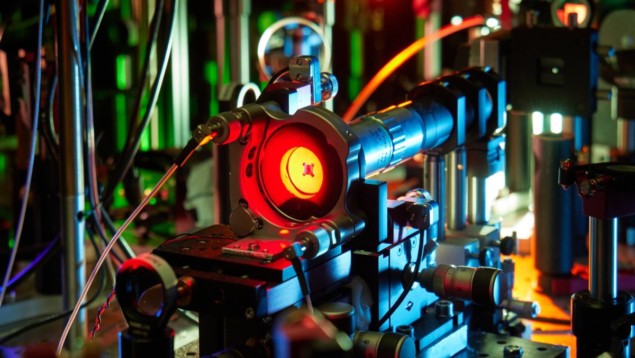
A gas of photons with nearly infinite compressibility has been created by Julian Schmitt and colleagues at the University of Bonn in Germany. The experimental first was achieved in a nanostructured, dye-filled optical cavity where the team created an ensemble of photons in a quantum degenerate state. Their experiment appears to confirm a peculiar prediction of quantum theory and could lead to the development of sensors that can measure tiny forces.
For familiar gases such as air, the pressure of a gas increases as its volume is reduced – which is how a hand-operated bicycle pump works. This means that compressing a gas becomes increasingly difficult as its volume is reduced. The situation, however, is much more complex in quantum gases. When the density becomes high enough, the wavefunctions describing the possible positions of individual atoms begin to overlap. At this point the gas enters the regime of quantum degeneracy and it becomes very important whether the atoms have integer or half-integer spin.
Atoms with integer spin (bosons) can occupy the same quantum state as their neighbours and at low temperatures a large fraction of the atoms will occupy the system’s lowest-energy state. This creates a distinct state of matter called a Bose–Einstein condensate (BEC), which is a macroscopic quantum state that extends across the entire system. One of the many peculiar properties of a BEC is that it is predicted to have an infinitely large compressibility.
Uniform distribution
Photons are also bosons, and in their experiment Schmitt’s team created a BEC from a 2D gas of photons contained within an optical microcavity. To avoid thermal fluctuations in the gas, which would prevent the photons from remaining in the same quantum state, the team filled the cavity with dye molecules. These absorb photons and then emit them at a uniform temperature of around 300 K. Using a specialized nanostructuring technique to manufacture the cavity, the team also ensured that the photons were uniformly distributed within it.

Bosons bossed into Bose–Einstein condensate
The team exerted a small compressive force on the gas by tilting one of the cavity mirrors. At lower densities, the team observed that the photons behaved much like a classical gas, becoming increasingly hard to compress as new photons were added to the system (adding photons has the same effect as reducing the volume). Yet strikingly, once the gas entered the quantum degenerate regime, it put up very little resistance to the compressive force. This implied that the gas had become almost infinitely compressible. As a result, Schmitt’s team hope that their microcavity setup could provide a way to measure tiny forces.
The research is described in Science.



